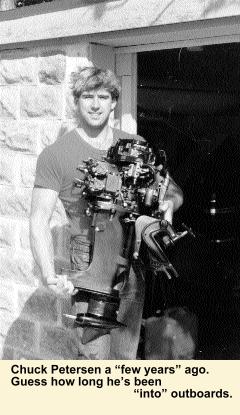by Chuck Petersen
While the famous Kiekhaefer classics of the 1950s soar in demand and price, outboard collectors and backyard racers may consider the second generation of race engines produced in the 1970s. With the last production of the four cylinder MK55H in 1959, Mercury stopped offering complete engines to the stock outboard racers while continuing to offer replacement parts for older models. This worked for a while but as new racers entered the sport during the 60s and 70s they found obtaining a competitive motor more difficult. Mercury responded by offering racing versions of their current production engines, the 25SS and 35SS and 60J motors.
 The two cylinder A and B classes were always very popular due to the compact size and affordability. The fishing Merc.MK20 motor went out of production in the 1950s and its descendants, the MK28and Merc 200 were 22 CID (up from 20 CID) models of similar powerhead design. The 25SS debuted in 1974 as a new racing class rather than complete head to head with the old 20H Class B Utilities and Hydros. The basic powerhead was similar to the 20hp service motor mounted naked (without cowlings) on a hydro short tower and Quicksilver lower unit. Other modification included raised port configuration and a larger carb, model KC16A. Two gear cases were offered, 16:21 or 1:1. In 1978, the tower section was beefed up. These motors were extremely lightweight and reliable. My first true race motor (see photo) was purchased used in 1980 from Dee Burghauer, a former national champion who was moving up to larger four cylinder C and D classes. I raced in the 25SS runabout class in 1983 but primarily used the motor to terrorize my lake neighbors. It still runs and looks like new. The 25SS was replaced by the larger 25XS in 1985.
The two cylinder A and B classes were always very popular due to the compact size and affordability. The fishing Merc.MK20 motor went out of production in the 1950s and its descendants, the MK28and Merc 200 were 22 CID (up from 20 CID) models of similar powerhead design. The 25SS debuted in 1974 as a new racing class rather than complete head to head with the old 20H Class B Utilities and Hydros. The basic powerhead was similar to the 20hp service motor mounted naked (without cowlings) on a hydro short tower and Quicksilver lower unit. Other modification included raised port configuration and a larger carb, model KC16A. Two gear cases were offered, 16:21 or 1:1. In 1978, the tower section was beefed up. These motors were extremely lightweight and reliable. My first true race motor (see photo) was purchased used in 1980 from Dee Burghauer, a former national champion who was moving up to larger four cylinder C and D classes. I raced in the 25SS runabout class in 1983 but primarily used the motor to terrorize my lake neighbors. It still runs and looks like new. The 25SS was replaced by the larger 25XS in 1985.
Another new APBA class was born in 1976 with the 35SS. Based on the 40hp model Merc 402 of 33.3 CID, it fit in between the existing 30 CID class MK 30H and 40 CID class D MK 55H. Unlike the 25SS, the 35SS had full wrap-around cowlings with a neat red stripe (fishing models had blue decals). These were two cylinder motors and thus vibrated a bit more than the four cylinder models. In addition, the heavy flywheel made cornering a bit dicey. 35SS was eventually merged into the D stock class due to lack of interest and very few were sold compared to the 25SS.
The J or junior class was designed to give youngsters a safe but exciting (25mph) introduction to the world of boat racing. The 6hp model 60 was produced between 1961 and 1968. The model 60J was a racing version mounted on its own tiny Quicksilver unit with 16:21 gears. The 7.26 CID motor did not see big production figures. At most local races in the 1980s a field of 3 was common, usually sons or daughters of established racers. The 60J was low on power and barely able to plane off the tiny rigs. In 1984,the 7.5J of 10.9 CID was introduced and worked much better.
While not true Antiques, these 25 year old motors will soon become desirable. Most parts that were shared with the service engines are readily available. The specific racing linkages and tower/ gearcase assemblies are harder to come by.
Happy Holidays to all at BSLOL. It was great to see you at Redwing, especially Big Bob blowing away the competition in his supercharged Sportsman!!

